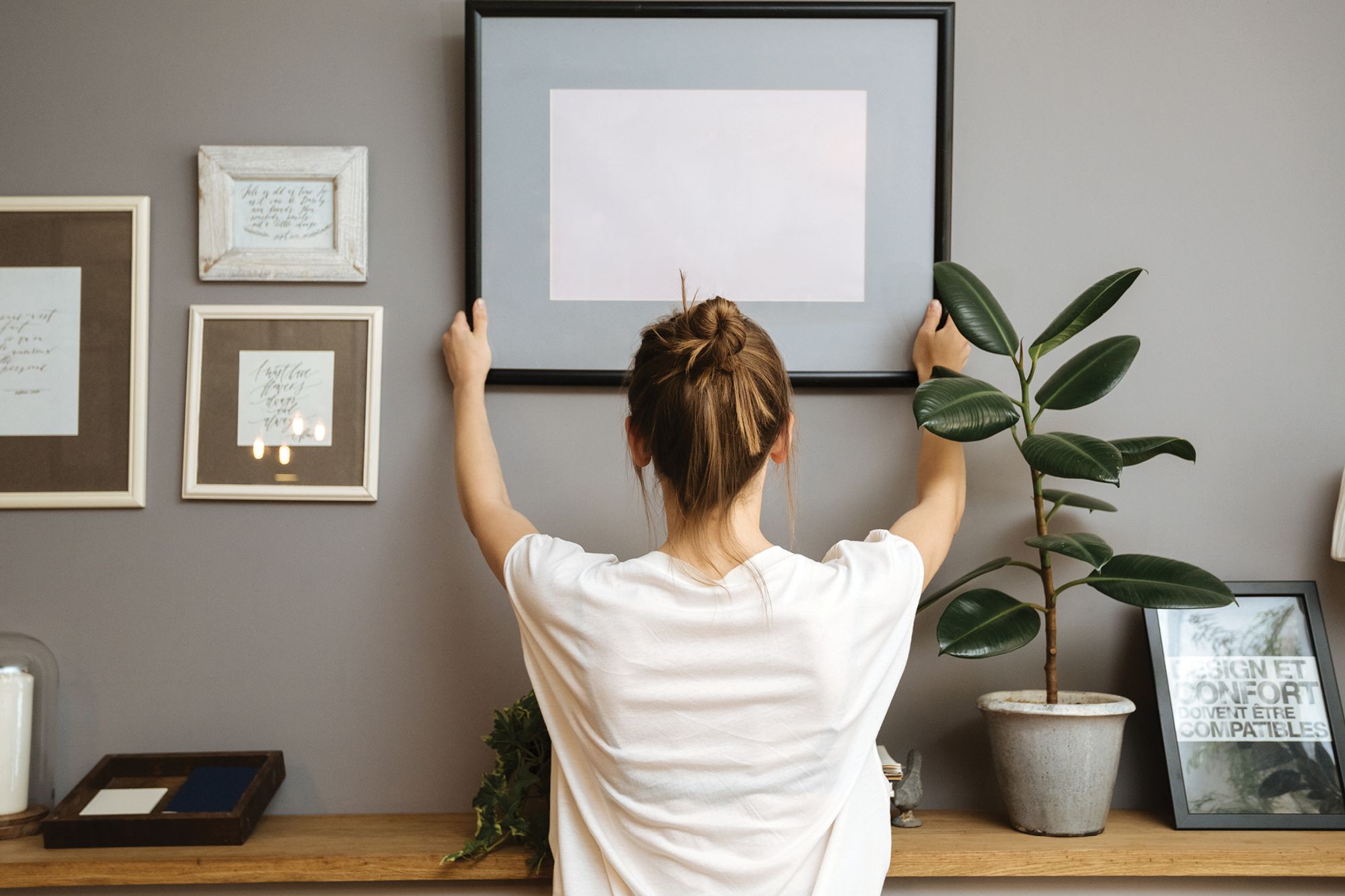
How to make your rental property feel like home
Whether you’re in a short-term rental or settled in for the longer term, you want the place you’re living in to feel like home. However, when that home is owned by somebody else, it’s important that any style changes you make to the property are either temporary or approved by the owner so you’ll get your bond back.
In Sydney, 14% of renters lose their bonds; one of the main reasons is due to damage to the property.[1] However, that doesn’t have to be you – there are a multitude of ways to bring your own style to your home environment without ever jeopardising your bond or status as a great tenant.
We’re sharing a few of our favourite suggestions in this article. Let’s dive in.
10 temporary décor ideas
These temporary décor ideas will make your rental property feel like home, but they can also pack up and travel with you to your next address. (For example – that first home you’ve been saving up for.)
It always pays to check rental laws or speak with your property manager and/or landlord if you’re unsure. If you get permission to make more permanent changes, make sure to get an agreement in writing before undertaking any modifications.
1. Liven it up with indoor plants
Adding plants and greenery to your rental is one of the most common ways to decorate your space. Not only do plants infuse life and brighten up the place, but they also positively impact the indoor environment by cleaning the air, removing toxins, and promoting relaxation.
Freestanding pots are one way to display your plants without damaging the property. These are ideal for larger spaces, like bedrooms and living rooms. Peace lilies, Mother-in-law’s tongue, ferns, ficuses, and aloe vera plants are popular indoor plant choices.
If you live in an apartment or a small rental where space is at a premium, terrariums are a great way to bring nature into your home. Think about adding one to your kitchen or bathroom.
2. Roll out the carpet
Indoor rugs can instantly elevate a room. They come in a rich range of colours, materials, and textures to suit every space in your home. Choose a neutral shade made from a natural texture for a beach house, or a patterned rug for a more modern home.
A rug rule of thumb: in most cases, bigger is better. If you can’t find one large enough for the space, buy two of the same pattern and place them next to each other.
Use rugs to partition different areas in your house, instantly making the room feel more spacious. These cosy insulators also protect floors from damage and they can make rooms less noisy.
3. Change the mood
The right interior lighting can make a huge difference to the look and feel of your home. Swap out lightbulbs or lampshades (which are easy and inexpensive to temporarily replace) to create a more warm and inviting atmosphere. Alternatively, add a striking floor or table lamp to add light and style to a room.
4. Undertake an easy kitchen makeover
The easiest and most cost-effective way to change the look of your kitchen is to simply swap out the hardware. Choose handles for drawers and cabinets that suit your taste and aesthetic, such as matt black or brushed brass for modern, or browse antique or second-hand stores to find vintage handles.
Just remember to note the dimensions of the existing handles so you can replace them with the same size, rather than adding additional holes to drawers and doors. Tuck the originals (with their fasteners) somewhere safe until you move out.
5. Cover up
There are a number of temporary coverings available for walls and floors. Temporary wallpaper is an excellent way to make your rental feel more like home without permanently altering the walls. To use it, peel and stick it to any wall you want to elevate, then gently remove it when it’s time to move out.
Temporary wallpaper can be applied to other surfaces, such as bathroom tiles, kitchen backsplashes, and even cabinet doors.
For the floors, try temporary, stick-on tiles (which can be peeled off when you move out), or look into interlocking vinyl planking, which is simple to install and can be removed later.
6. Dress the windows
If you don’t like the current curtains or window coverings in your rental property, or they let in too much (or not enough) light, swap them out with something to suit your style and light preferences. Choose from a wide range of textured curtains, colours, or blinds.
Remember, keeping the original window coverings and reinstalling them when your lease is up is essential. It’s also important to ensure you don’t create any new holes in the wall when installing your new curtains or blinds. Speak to your property manager or landlord if you have any questions or concerns.
7. Make a statement
Statement furniture makes an instant impression. Invest in beautiful pieces that create an aesthetic, or select one-of-a-kind showstoppers that bring a smile to your face every time you look at them.
If you’re working with a small space, make sure everything earns its place by doing double duty. For example, choose a sofa that folds out into a bed for guests, or select a coffee table that features drawers and cupboards for extra storage.
These don’t need to be expensive purchases – even a handful of vibrant throw cushions will brighten the room and make it feel more like home.
8. Grow a garden
If you’re living in a rental property, you can grow an outdoor garden. Invest in a raised garden bed, vertical wall garden, or outdoor pots to grow herbs, vegetables, fruit trees, and flowers. There are plenty of small backyard ideas to get you growing and help your space feel more permanent. Best of all, they can travel with you if you change addresses.
9. Screen your space
Indoor and outdoor screens are excellent ways to introduce privacy to your home. Indoor screens make fantastic room separators. Use them to partition off a home office, for example. Outdoor screens help create a private space, free from the eyes of neighbours. They’re also a great way to partition off bins or garden equipment.
10. Display moments, memories, and art
One of the best things you can do to make a rental property feel like home is to hang some pictures. This might be art, family photographs, or pictures taken during your travels or favourite moments.
Hanging pictures in a rental tends to give renters pause, as they’re afraid of damaging the walls and losing their deposit. However, there are so many picture-hanging solutions, systems, hooks, and materials available that you can hang your photos with confidence.
How to hang pictures in a rental
What’s the best way to remove removable picture hooks without damaging the wall?
To remove adhesive picture hooks without causing damage, carefully follow the instructions on the packaging. Pull the strip slowly and gently downwards parallel to the wall until it releases. Avoid pulling outwards, as this can damage the paint.
What type of artwork works best in a rental?
When renting, lightweight canvas prints, framed posters, or art prints are excellent choices, especially when using non-permanent methods to hang them.
Hanging pictures in a rental is easy if you follow these five simple steps.
1. Use removable picture hooks. These renter-friendly hooks have removable adhesive strips that allow you to stick them directly on the wall, removing them cleanly later.
Tip: Make sure you select a hook suitable for the size and weight of the artwork or picture you want to hang.
2. Lean larger artwork against the wall. If you can’t get permission from your property manager or landlord to hang larger pieces, a unique way to showcase them is to lean them against the wall in a focal point of the room, either on the floor or on top of a cabinet.
Tip: You could also invest in a stand to display the artwork, as well. Browse art supply or antique stores.
3. Use Japanese washi tape. Get creative! Frame photographs or artwork with decorative Japanese washi tape, which comes in a mind-boggling array of colours and patterns. Simply tear off lengths of the tape and create a frame around your picture, securing it to the wall.
Tip: This tape isn’t suitable for hanging heavy artwork.
4. Utilise hanging rails or picture ledges. A picture rail or a picture ledge is a great option to hang art without damaging the walls. All you need to do is install the picture rail or ledge along the top of your wall (typically done with adhesive strips) and hang your art.
Tip: Position frames away from direct sunlight to avoid fading or damage.
5. Use string or wire. Create a casual vibe by using string or wire to hang your pictures or artwork. Stretch a piece of string or wire from one end of a wall to the other (securing in place with tack or Japanese washi tape) and use it to display small pieces of art, such as photos or paper artwork.
Tip: Use mini pegs or paper clips to hang the picture from the string or wire.
Tips for avoiding damage when hanging pictures in a rental
When hanging pictures on the wall in a rental property, it’s important to do it carefully and not damage the wall, as this could result in you not getting your bond back. Follow these six tips for hanging pictures in a rental.
- Choose the solution that best suits the picture, considering its weight, size, and where you want to display it.
- Use lightweight frames.
- Clean the wall before applying any adhesive or tape. (Dirt or dust can reduce its effectiveness.)
- Make sure the artwork or picture is level so it doesn’t fall and damage the floor.
- Distribute the weight. If you’re worried about heavy frames or large artwork, try distributing the weight across multiple strips or hooks to keep it secure.
- Speak with your property manager or landlord if you have questions or want permission to hang important items more securely. Make sure to get any agreements in writing.
Additional considerations
Check your lease agreement to see if there are any specific rules about hanging pictures or making holes in the walls.
It’s also important to take wall materials into consideration. Depending on the type of walls in your rental (plaster, drywall, brick), research the best temporary solution for hanging pictures. For example, adhesive strips may not work on uneven brick walls.
When using non-permanent methods to hang your pictures, keep the weight of them in mind. Heavy frames or large artworks may require additional support.
Summing up
Decorating and hanging pictures in your rental property is one of the easiest ways to make it feel more like home. However, it is essential to use the correct methods to avoid damaging the walls, ensuring you get your bond back.
If you have any questions about decorating a rental property, ask the real estate experts. At DiJones, we’re here to help.
FAQs
Are nails allowed in rental properties?
Using nails and screws to hang pictures is generally not recommended in rental properties unless specified in your lease or approved by your property manager or landlord. If you’re unsure, check with your landlord first. If you do use nails or screws, remember to patch the holes before moving out.
How do I make sure pictures are straight when hanging them?
To ensure your pictures are level, use a level tool before hanging them. You can also use a measuring tape to find the centre of the wall and space out pictures evenly.
What if I accidentally damage the wall while hanging art?
If you accidentally damage the wall while hanging pictures, repair it immediately. Use spackling paste to fill any holes and touch up the paint. If you aren’t sure how to fix the damage, your landlord may be able to help or offer guidance on how to make repairs before you move out.
Sources
[1] Tenants.org: Bond Loss Tracker. Sourced February 2025.
Was this content helpful to you?






